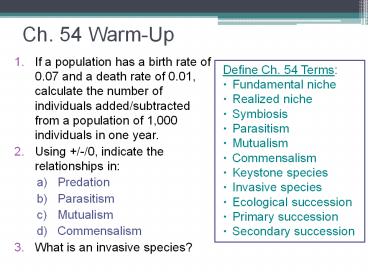Ch. 54 Warm-Up PowerPoint PPT Presentation
1 / 23
Title: Ch. 54 Warm-Up
1
Ch. 54 Warm-Up
- If a population has a birth rate of 0.07 and a
death rate of 0.01, calculate the number of
individuals added/subtracted from a population of
1,000 individuals in one year. - Using /-/0, indicate the relationships in
- Predation
- Parasitism
- Mutualism
- Commensalism
- What is an invasive species?
- Define Ch. 54 Terms
- Fundamental niche
- Realized niche
- Symbiosis
- Parasitism
- Mutualism
- Commensalism
- Keystone species
- Invasive species
- Ecological succession
- Primary succession
- Secondary succession
2
Chapter 54Community Ecology
3
You Must Know
- The difference between a fundamental niche and a
realized niche. - The role of competitive exclusion in
interspecific competition. - The symbiotic relationships of parasitism,
mutualism, and commensalism. - The impact of keystone species on community
structure. - The difference between primary and secondary
succession.
4
- Community group of populations of different
species living close enough to interact
5
Interspecific interactions
- Can be positive (), negative (-) or neutral (0)
- Includes
- Competition (-/-)
- Predation (/-)
- Herbivory (/-)
- Symbiosis parasitism, mutualism, commensalism
- Facilitation (/ or 0/)
6
(No Transcript)
7
- Interspecific competition resources are in short
supply - Species interaction is -/-
- Competitive exclusion principle Two species
cannot coexist in a community if their niches are
identical. - The one with the slight reproductive advantage
will eliminate the other - Resource partitioning differences in niches that
enable similar species to coexist
8
(No Transcript)
9
Ecological niche the sum total of an organisms
use of abiotic/biotic resources in the environment
- Fundamental niche niche potentially occupied by
the species - Realized niche portion of fundamental niche the
species actually occupies
10
Predation (/-)
- Defensive adaptations include
- Cryptic coloration camouflaged by coloring
- Aposematic or warning coloration bright color
of poisonous animals - Batesian mimicry harmless species mimic color
of harmful species - Mullerian mimicry 2 bad-tasting species
resemble each other both to be avoided - Herbivory plants avoid this by chemical toxins,
spines, thorns
11
(No Transcript)
12
- Symbiosis 2 species live in direct contact with
one another - Parasitism (/-), mutualism (/), commensalism
(/0)
Commensalism
Mutualism
13
Community Structure
- Species diversity species richness ( of
different species) relative abundance of each
species. - Which is most diverse?
- Community 1 90A, 10B, 0C, 0D
- Community 2 25A, 25B, 25C, 25D
- Community 3 80A, 5B, 5C, 10D
- Shannon Diversity Index calculate diversity
based on species richness relative abundance - Highly diverse communities more resistant to
invasive species
14
Invasive Species
- Organisms that become established outside native
range - Kudzu vine plant from Japan, noxious weed that
kills trees shrubs
15
Invasive Species
- Dutch elm disease fungus carried by beetles
(vector) zoonotic pathogen - Arrived in U.S. on logs imported from Netherlands
- Death of many elm trees across U.S., Europe,
Canada - Try to cultivate resistant strains of elm trees
16
Invasive Species
- Potato Blight fungus-like disease caused Irish
Potato Famine in 1840s - Arrived in Ireland from ships coming from U.S.
- Only 1 species of potato planted in Ireland ? all
susceptible to disease - 1 million people died
- Problem with monoculture lack of genetic
diversity of crops
17
Trophic Structures
- The trophic structure of a community is
determined by the feeding relationships between
organisms. - Trophic levels links in the trophic structure
- The transfer of food energy from plants ?
herbivores ? carnivores ? decomposers is called
the food chain.
18
- What limits the length of a food chain?
- Energetic hypothesis
- Inefficiency of energy transfer along chain
- Dynamic stability hypothesis
- Long food chains less stable than short chains
Fig. 53.10
19
- Two or more food chains linked together are
called food webs. - A given species may weave into the web at more
than one trophic level.
20
- Dominant species has the highest biomass or is
the most abundant in the community - Keystone species exert control on community
structure by their important ecological niches - Loss of sea otter ? increase sea urchins,
destruction of kelp forests - Grizzly bear (transfer nutrients from sea ? land
by salmon diet) - Prairie dogs (burrows, soil aeration, trim
vegetation)
21
- Bottom-Up Control
- Unidirectional influence from lower trophic
levels to higher levels - Soil nutrient ? plants ? herbivores ? carnivores
- Top-down Control
- Predation mainly controls community organization
by limiting herbivores which in turn limit plants
that affect soil nutrient content - Carnivores ? herbivores ? plants ? soil nutrients
22
Disturbances influences species diversity and
composition
- A disturbance changes a community by removing
organisms or changing resource availability
(fire, drought, flood, storm, human activity) - Intermediate disturbance hypothesis best type
of disturbance, foster species diversity - Ecological succession transitions in species
composition in a certain area over ecological
time
23
Primary Succession
- Plants animals invade where soil has not yet
formed - Ex. colonization of volcanic island or glacier
24
Secondary Succession
- Occurs when existing community is cleared by a
disturbance that leaves soil intact - Ex. abandoned farm, forest fire
25
Biogeographic Factors
- Important factors
- Latitude species more diverse in tropics than
poles - Area larger areas more diverse
- Biogeographic islands natural labs for studying
species diversity - Influenced by size and distance
- Larger islands ? greater immigration, lower
extinction - Far from mainland ? immigration falls, extinction
rates increase

